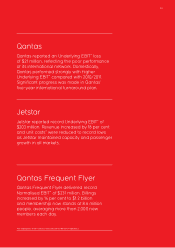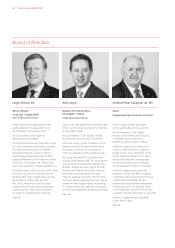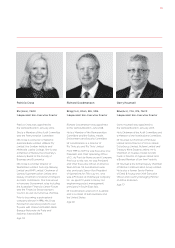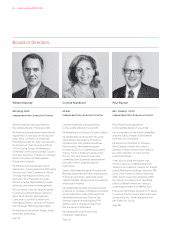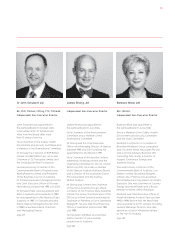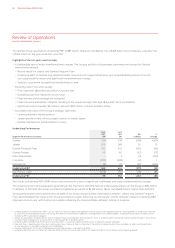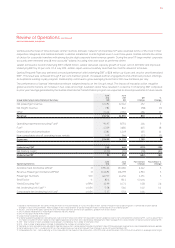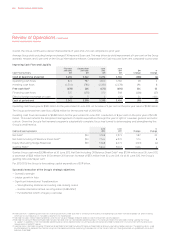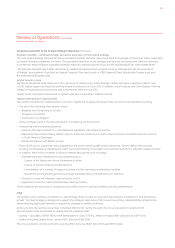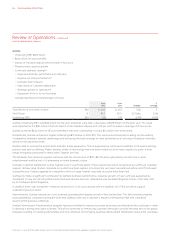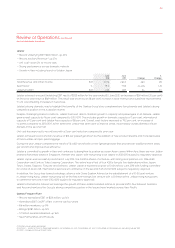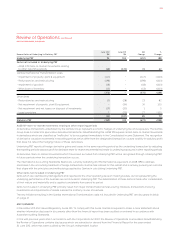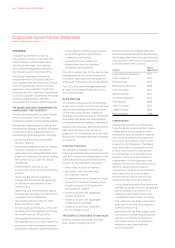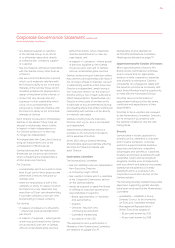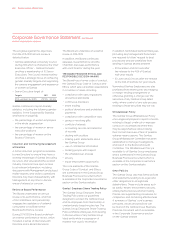Qantas 2012 Annual Report Download - page 23
Download and view the complete annual report
Please find page 23 of the 2012 Qantas annual report below. You can navigate through the pages in the report by either clicking on the pages listed below, or by using the keyword search tool below to find specific information within the annual report.
FOR THE YEAR ENDED 30 JUNE 2012
Review of Operations continued
Successful execution of the Group’s strategic objectives continued
Domestic strength - achieved through successful execution of multi brand strategy
The multi brand strategy allowed the Group to position Qantas’ domestic network as ‘best for business and premium travel’ supported
by Jetstar offering consistently low fares. The successful execution of the strategy is evidenced by Qantas and Jetstar continuing
to be the two most profitable Australian domestic networks, maintaining the Group’s profit maximising 65 per cent market share.
This domestic strength was further reinforced by additional Frequent Flyer program product offerings through the acquisition
of Wishlist, development of epiQure by Qantas Frequent Flyer and launch of CBA Diamond Direct, Woolworths Qantas card and
the NAB Qantas Business card.
Jetstar Growth in Asia
Significant milestones were achieved in the execution of Jetstar’s pan-Asian strategy. Jetstar Asia grew capacity by 38 per cent
in 2012. Jetstar Japan launched five months ahead of schedule on 3 July 2012. In addition, a joint venture with China Eastern Airlines
(Jetstar Hong Kong) was announced and is planned to launch in mid 2013.
Jetstar Pacific has been restructured for growth with new local partner, Vietnam Airlines.
Qantas International Transformation
The Qantas International Transformation is on track. Significant progress has been made on announced initiatives including:
— The exit of the following international routes:
— Bangkok and Hong Kong to London
— Singapore to Mumbai
— Auckland to Los Angeles
These changes result in the early retirement of six Boeing 747-400 aircraft.
— Deepening and broadening alliances
— Antitrust immunity received for a Joint Business Agreement with American Airlines
— Network enhancements linking directly with the American Airlines hub in North America (Dallas-Fort Worth) and the LAN hub
in South America (Santiago)
— Enhanced network with British Airways
— Seven B747s (out of a planned nine) upgraded to the award-winning A380 product standard. Twelve A380s in the process
of being reconfigured by adjusting the cabin layout and seating mix to better suit customer demand for different classes of travel.
— In addition, there were a number of announcements through the year including:
— Streamlining heavy maintenance and engineering via:
- Closure of the Melbourne Heavy Maintenance facility
- Closure of Sydney Component Maintenance
- Consolidation of a number of support activities into the remaining maintenance facilities
- Streamlining of engineering practices through implementation of Maintenance on Demand
— Decision to close the Adelaide catering facility in 2013
— Agreement to sell the Cairns and Riverside catering facilities
These initiatives are expected to contribute around $300 million in annual benefits once fully implemented.
Fleet
The Qantas Group remains committed to a fleet strategy that provides for long-term fleet renewal, simplification and disciplined
growth. The fleet strategy is designed to support the strategic objectives of the Group’s two strong complementary flying brands,
whilst retaining significant flexibility to respond to changes in market conditions.
At 30 June 2012, the Qantas Group fleet comprised 308 aircraft. During the year, the Group acquired 37 owned aircraft
(34 purchased, three purchased ex-lease) and five leased aircraft:
— Qantas – two A380s, 13 B737-800s, three Bombardier Q-400s, 10 F100s , three ex-leased B767-300s and two B717-200s
— Jetstar (including Jetstar Asia) – seven A320-200s, two A330-200s
The Group retired 14 aircraft during the year (five B747-400s, two B767-300s and seven B737-400s).
021


